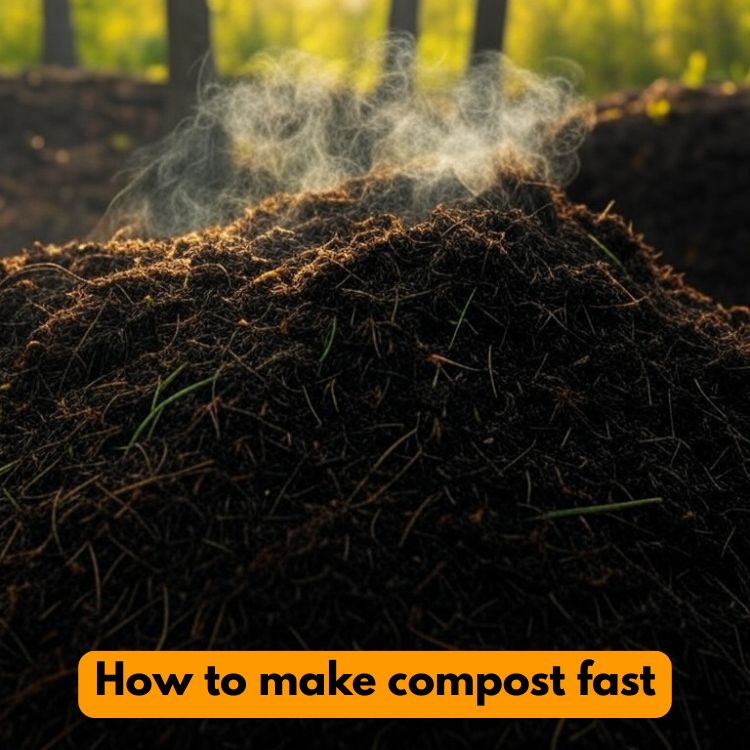Learning How To Make Compost Fast with this detailed guide, packed with tips on material balance, natural activators, and maintaining perfect conditions.
Revving Up the Rot: The Art of Fast Composting

The speed of nature doesn’t always align with our patience, especially when it comes to composting.
After years of trial and error, I’ve been on a mission to master the art of fast-tracking compost for my garden. Imagine concocting your own garden gold in a mere three months!
Let’s dig into some tried-and-true techniques that promise to invigorate your compost pile and accelerate its transition into gardener’s gold.
Balancing the Greens and Browns
When it comes to composting, achieving the right balance between green and brown materials is crucial. But what exactly does that mean?
Let’s dive into the world of composting and explore how we can master this balance.
Understanding Green Materials
Green materials are rich in nitrogen, which is essential for the composting process. They tend to be sappier and fleshier in texture.
Think of them as the protein of your compost pile. They provide the necessary nutrients that help break down organic matter.
Interestingly, not all green materials are obvious. Did you know that coffee grounds and tea leaves are considered greens?
Despite their brown appearance, they have a high nitrogen content. It’s like finding a hidden gem in your morning routine!
“Green materials tend to have a higher nitrogen content and will be sappier and fleshier in texture.”
Recognizing Brown Materials
On the flip side, brown materials are rich in carbon. They are drier and coarser, providing the structure needed for composting.
Think of them as the carbohydrates of your compost pile. They help to balance the moisture and provide energy for the microbes.
- Dried leaves
- Twigs and prunings
- Wood chippings
- Straw
- Shredded newspaper
- Torn cardboard
These materials are abundant, especially during the fall when leaves are plentiful.
It’s like nature’s way of giving us a helping hand!
The Magic Ratio: 50/50
So, how do we achieve the perfect balance? Aim for a 50% mix of green materials and 50% brown materials.
This ratio helps speed up the composting process, creating a harmonious environment for microbes to thrive.
But why is this balance so important? Imagine baking a cake. T
oo much flour, and it’s dry. Too much liquid, and it’s soggy.
Composting is similar. The right mix ensures that your compost pile is neither too wet nor too dry, creating the perfect conditions for decomposition.
Chop, Chop, Chop!
One crucial tip: chop your materials into smaller pieces. Why? Smaller pieces increase the surface area, making it easier for microbes to break them down.
It’s like cutting your food into bite-sized pieces for easier digestion.
Whether it’s grass clippings or dried leaves, taking the time to chop them up can make a significant difference.
It’s a small step that leads to big results!
Unconventional Greens
Let’s talk about those unconventional green materials. Coffee grounds, for instance, are a fantastic addition to your compost pile.
They might look brown, but they’re packed with nitrogen. It’s like a secret weapon in your composting arsenal.
Similarly, tea leaves, even after brewing, retain their nitrogen content.
So, don’t toss them out! Add them to your compost pile and watch them work their magic.
This superb easy to follow video will really help you understand how to do it!
Conclusion
Balancing greens and browns in your compost pile is both an art and a science.
By understanding the role of each material and aiming for that perfect 50/50 mix, we can create a thriving environment for decomposition.
So, the next time you’re in the garden or kitchen, think about how you can contribute to this balance. Happy composting!
Activators: Nature’s Secret Catalyst
Have you ever wondered how to speed up your composting process naturally? Well, let me share a little secret with you.
It’s all about using natural activators. These are the unsung heroes of composting, quietly working their magic to transform your waste into rich, fertile soil.
Why Choose Natural Activators?
First things first, why should we opt for natural activators? Simply put, they are packed with high nitrogen levels.
This is crucial because nitrogen is a key ingredient in the decomposition process. It acts like a turbo boost for your compost pile, helping it break down faster and more efficiently.
Now, you might be tempted to grab a store-bought compost accelerator. But here’s the thing: they’re often pricey and, quite frankly, unnecessary. As one wise gardener once said,
“The very best activator is the manure of herbivorous animals.”
So, let’s dive into some natural options that won’t break the bank.
Herbivore Manure: The Gold Standard
When it comes to natural activators, herbivore manure is king.
Whether it’s chicken droppings, cow or horse manure, or even rabbit pellets, these materials are rich in nitrogen and perfect for kick-starting your compost.
If you’re lucky enough to have access to these, consider yourself blessed!
But what if you don’t have a farm or a friendly neighbor with a stable?
No worries. You can still get your hands on some powerful activators.
Coffee Grounds: A Surprising Ally
Believe it or not, coffee grounds are an excellent natural activator. They might seem like a waste product, but they’re actually a treasure trove of nutrients.
Most coffee shops are more than happy to give them away for free. Just ask, and you’ll likely walk away with a bag full of compost-boosting goodness.
Mix and Turn: The Oxygen Factor
Now, let’s talk about another crucial aspect of composting: oxygen. Regularly mixing and turning your compost pile is essential.
Why? Because it introduces oxygen, which is vital for the microorganisms that break down the organic matter.
Without oxygen, your compost pile can become a smelly, anaerobic mess.
Think of it like this: your compost pile is a living, breathing organism. It needs air to thrive. So, grab a spade or a pitchfork and give it a good turn every week or two.
Yes, it’s a bit of hard work, but the results are worth it.
You’ll notice your compost heating up, a sign that those beneficial bacteria are hard at work.
Alternative Options: Get Creative
If you’re running low on traditional activators, don’t fret. There are plenty of creative solutions out there.
For instance, if you have neighbors with guinea pigs or rabbits, their bedding can be a fantastic addition to your compost.
The combination of straw, shavings, and droppings makes for a potent mix.
And let’s not forget about the power of liquid gold. Yes, I’m talking about urine. It might sound a bit unconventional, but it’s a fantastic source of nitrogen.
If you’re comfortable with it, consider adding a bit to your compost pile. Just be sure to dilute it with water to avoid overwhelming the system.
Final Thoughts: Embrace the Process
Composting is a journey, not a destination. It’s about finding what works best for you and your garden.
By embracing natural activators and regularly turning your pile, you’ll be well on your way to creating rich, fertile soil that your plants will love.
So, the next time you’re sipping your morning coffee or cleaning out the rabbit hutch, remember that you’re holding a powerful tool in your hands.
Use it wisely, and watch your compost come to life.

All-Weather Composting
Composting is a fantastic way to recycle organic waste and enrich your garden soil. But what happens when the weather doesn’t cooperate?
Rain, snow, or even a dry spell can throw a wrench in your composting plans. So, how do we keep our compost heaps thriving all year round?
Let’s dive into some practical tips for all-weather composting.
Why Covering Matters
Rain can be a real nuisance for compost heaps. Imagine a sponge left out in the rain. It gets soggy, heavy, and loses its effectiveness.
The same goes for your compost. Covering your heap during rain is crucial to prevent it from becoming waterlogged.
A soggy heap can lead to anaerobic conditions, which means your compost will start to smell and break down inefficiently. Not nice!
As we head into winter, covering your compost heap is even more important. It acts as an insulator, keeping the internal temperature up and the composting process active.
You can use any type of sheeting, or even several layers of cardboard. Just make sure it sheds most of the rain.
If you’re considering old carpet, ensure it’s made from natural fibers like jute or hemp. We don’t want man-made materials ending up in our compost, do we?
“To cover or not to cover? That is the question.”
Insulation for Winter Activity
Winter can be harsh, but it doesn’t have to halt your composting efforts. Keeping heaps insulated is key to promoting activity during the colder months.
When temperatures drop, the decomposition process slows down.
By insulating your heap, you can keep things active for longer. Think of it like wrapping a warm blanket around your compost. It retains heat and keeps the microbes happy and working.
Moisture Balance: Not Too Wet, Not Too Dry
Moisture balance is crucial for a healthy compost heap. It should feel like a damp sponge—not too wet, not too dry.
If it’s too wet, it becomes heavy and slumps down, turning into a putrid, smelly mess. If this happens, dig it out, restack it with more browns (like dried leaves or straw), and keep it covered.
On the flip side, if your compost gets too dry, it won’t break down efficiently. How do you tell if it’s wet enough?
Get your hand in there, grab some material, and give it a good squeeze. It should feel moist but not dripping.
If it’s dry, use a watering can to give it a thorough watering once or twice a week. This ensures the microbes have enough moisture to do their job.

Practical Tips for All-Weather Composting
- Cover heaps during rain to prevent sogginess and maintain aerobic conditions.
- Insulate heaps in winter to keep the composting process active.
- Maintain moisture balance by ensuring the heap is damp but not wet.
Remember, composting is a bit like cooking. You need the right ingredients, the right conditions, and a bit of patience.
By following these tips, you can keep your compost heap healthy and productive, no matter the weather.
Conclusion
In conclusion, all-weather composting is about adapting to the elements. Whether it’s rain, snow, or dry spells, we can take steps to ensure our compost heaps remain active and efficient.
By covering heaps during rain, insulating them in winter, and maintaining the right moisture balance, we can keep the composting process going strong.
So, next time you look at your compost heap, ask yourself: “To cover or not to cover?” The answer could make all the difference in your quest for rich, fertile compost.








